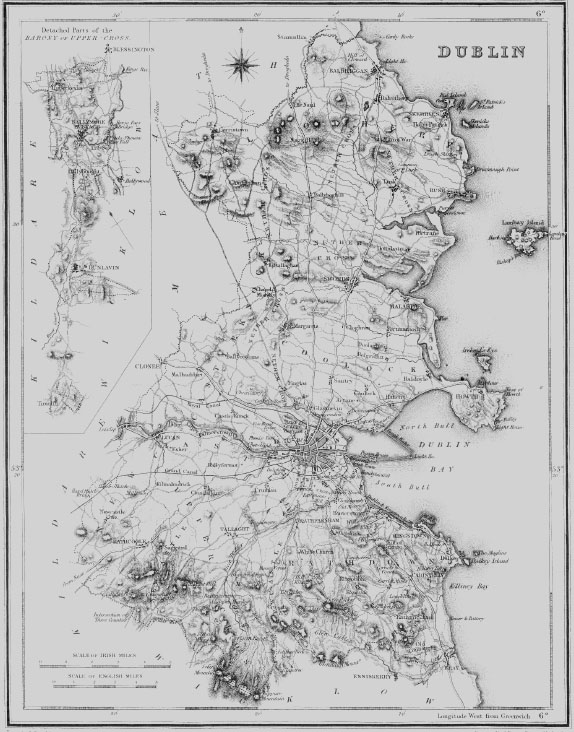| Accompanying Lewis map for Dublin 
|
| CABINTEELY |
| CABINTEELY, a village, partly in the parish of KILLINEY, hut chiefly in that of TULLY, half-barony of RATHDOWN, county of DUBLIN, and province of LEINSTER, 6? miles (S. S. E.) from Dublin: the population is returned with the respective parishes. This place, which is situated on the road from Dublin to Bray, is a constabulary police station, and has a twopenny post to Dublin : it comprises a number of small irregularly built houses, and a R. C. chapel for the union or district of Kingstown. In the vicinity are several handsome seats, the principal of which is Cabinteely House, the residence of the Misses Byrne, descended from the O'Byrne dynasty of Wicklow: the house forms three sides of a square, commanding extensive views of the bays of Dublin and Killiney, with the beautiful adjacent country; and the demesne is adorned with thriving plantations and presents many natural beauties. Among the other seats are Brenanstown House, the admired residence of G. Pim, Esq.; and Glen-Druid, of Mrs. Barrington. Near Loughlinstown, on the right of the road leading to Bray, is the site of an extensive encampment, held there in 1797 and for several years after the disturbances in 1798. At Glen-Druid there is a very perfect cromlech, consisting of six upright stones supporting one of 14 feet by 12, which is supposed to weigh about 25 tons. |
| CARRICKMINES |
| CARRICKMINES, a village, in the parish of TULLY, half-barony of RATHDOWN, county of DUBLIN, and province of LEINSTER, 7 miles (S. S. E.) from Dublin. Fairs are held on Jan. 12th, April 14th, June 24th, and Oct. 14th; and here are the remains of an old castle. |
| SANDYFORD |
| SANDYFORD, a village, in the parish of TULLY, barony of HALF-RATHDOWN, county of DUBLIN, and province of LEINSTER, 5 miles (S.) of Dublin, on the old road to Enniskerry ; the population is returned with the parish. This is the head of the R. C. union or district of Sandyford and Glancullen, comprising the parishes of Kilternan and Kilgobbin, and portions of those of Tullow, Rathmichael, Stillorgan, Kill, and Taney: the chapel is a spacious building, which, though commenced 20 years since, is not yet finished ; attached is a good residence for the priest : another chapel is at Glancullen, in the parish of Kilternan. There is a school in connection with the new Board of Educa-tion. |
| TULLY |
| TULLY, or TULLOW, also called BULLOCK, a parish, in the barony of HALF-RATHDOWN, county of DUBLIN, and province of LEINSTER ; containing with the villages of Cabinteely and Carrickmines (each separately described), 1385 inhabitants. The former, which is the principal village, is situated 6- miles (S. S. E.) from Dublin, on the road to Bray. At the village of Golden-Ball, the eastern side of which is in this parish, is a twopenny post-office. The parish comprises 2845 statute acres, chiefly in a high state of cultivation, and embellished with numerous seats and well-planted de-mesnes. Granite and firestone are procured at Murphystown. Near Rockville is a deep and romantic glen of dingle. The principal seats are Leopardstown, the handsome residence of Fenton Hort, Esq., situated in a demesne of about 200 acres, the pleasure grounds of which are tastefully laid out, and command magnificent views of the bay of Dublin, Killiney hills, Bray Head and Wicklow and Dublin mountains ; Brenanstown House, the handsome and substantial mansion of Geo. Pim, Esq., also situated in a fine demesne ; Cherryfield, the residence of the Rev. J. Hunt ; Rocklands, of J. H. Duane, Esq. ; Rockville, of C. W. Roche, Esq., commanding a fine view of the bay of Killiney ; Glanamuck, of Jos. Strong, Esq. ; Priorsland, of the Rev. L. H. Bolton ; Kingstown House, of the Rev. M. Mc Namara ; North Lodge, of John Gilbert, Esq. : Carrickmines Castle, of Robt. Taylor, Esq., in the grounds of which are the remains of the ancient castle of that name ; Bellmont, of Thos. Smith, Esq., M. D., commanding a magnificent mountain view ; and Glen Druid, of Mrs. Barrington, which derives its name from a very perfect cromlech or druidical altar situated in a pic-turesque and richly wooded glen watered by a mountain stream ; from the summit of a lofty tower, erected by the late Mr. Barrington, is obtained a splendid view of the sea, with the hills of Howth and Killiney, Bray Head, the Sugar Loaves, Djouce, and the Three Rock and Shankill mountains, and the beautiful country in the foreground. It is a rectory and curacy, in the diocese of Dublin ; the rectory forms part of the corps of the deanery of Christ-Church, and the curacy part of the union of Monkstown : the tithes amount to £291. 18., two-thirds of which are payable to the dean, and the remainder to the curate. In the R. C. divisions it is chiefly in the union or district of Kingstown, and has a chapel at Cabinteely. At Clonkeen is a school aided by subscription, in which about 70 children are educated, and about 40 are taught in a private school at Cabinteely. According to Ledwich, the church of Tully was founded by the Ostmen and dedicated to their favourite saint, Olave ; its ruins, situated on an eminence, still form a picturesque object, and its circular arches bear evidence of its remote antiquity. Near the church are the remains of some ancient crosses with traces of rudely sculptured figures. The cromlech at Glen Druid consists of a large table stone, 14 feet long and 12 broad, supported by six upright stones : the former is supposed to weigh about 25 tons. At Murphystown are the remains of an ancient castle. |
|